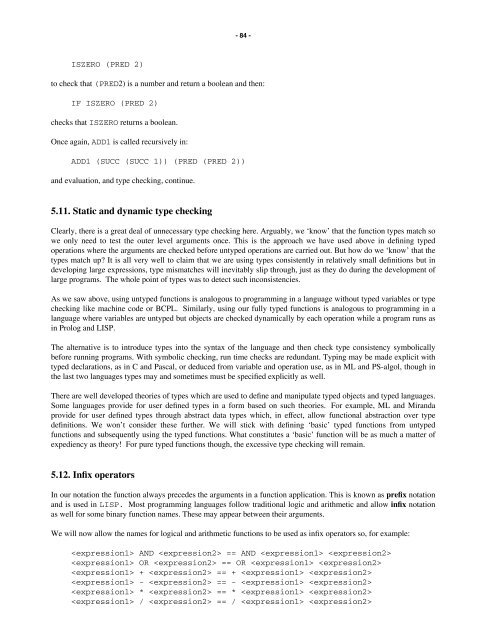An Introduction to Functional Programming Through Lambda Calculus
An Introduction to Functional Programming Through Lambda Calculus
An Introduction to Functional Programming Through Lambda Calculus
Create successful ePaper yourself
Turn your PDF publications into a flip-book with our unique Google optimized e-Paper software.
- 84 -ISZERO (PRED 2)<strong>to</strong> check that (PRED2) is a number and return a boolean and then:IF ISZERO (PRED 2)checks that ISZERO returns a boolean.Once again, ADD1 is called recursively in:ADD1 (SUCC (SUCC 1)) (PRED (PRED 2))and evaluation, and type checking, continue.5.11. Static and dynamic type checkingClearly, there is a great deal of unnecessary type checking here. Arguably, we ‘know’ that the function types match sowe only need <strong>to</strong> test the outer level arguments once. This is the approach we have used above in defining typedoperations where the arguments are checked before untyped operations are carried out. But how do we ‘know’ that thetypes match up? It is all very well <strong>to</strong> claim that we are using types consistently in relatively small definitions but indeveloping large expressions, type mismatches will inevitably slip through, just as they do during the development oflarge programs. The whole point of types was <strong>to</strong> detect such inconsistencies.As we saw above, using untyped functions is analogous <strong>to</strong> programming in a language without typed variables or typechecking like machine code or BCPL. Similarly, using our fully typed functions is analogous <strong>to</strong> programming in alanguage where variables are untyped but objects are checked dynamically by each operation while a program runs asin Prolog and LISP.The alternative is <strong>to</strong> introduce types in<strong>to</strong> the syntax of the language and then check type consistency symbolicallybefore running programs. With symbolic checking, run time checks are redundant. Typing may be made explicit withtyped declarations, as in C and Pascal, or deduced from variable and operation use, as in ML and PS-algol, though inthe last two languages types may and sometimes must be specified explicitly as well.There are well developed theories of types which are used <strong>to</strong> define and manipulate typed objects and typed languages.Some languages provide for user defined types in a form based on such theories. For example, ML and Mirandaprovide for user defined types through abstract data types which, in effect, allow functional abstraction over typedefinitions. We won’t consider these further. We will stick with defining ‘basic’ typed functions from untypedfunctions and subsequently using the typed functions. What constitutes a ‘basic’ function will be as much a matter ofexpediency as theory! For pure typed functions though, the excessive type checking will remain.5.12. Infix opera<strong>to</strong>rsIn our notation the function always precedes the arguments in a function application. This is known as prefix notationand is used in LISP. Most programming languages follow traditional logic and arithmetic and allow infix notationas well for some binary function names. These may appear between their arguments.We will now allow the names for logical and arithmetic functions <strong>to</strong> be used as infix opera<strong>to</strong>rs so, for example: AND == AND OR == OR + == + - == - * == * / == /
















